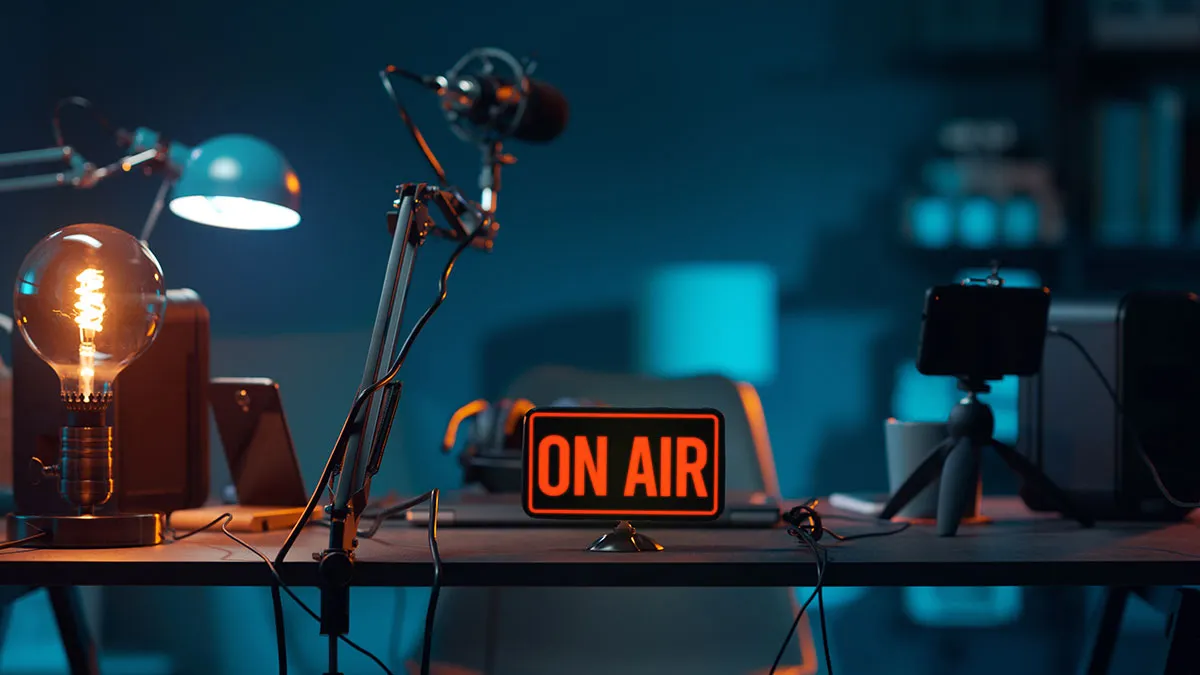Indeed, investing in a quality podcasting microphone is crucial, but the path to crystal-clear audio isn’t solely paved by the microphone’s cost or quality. The way you wield your microphone plays a pivotal role, encompassing factors such as your recording environment, equipment positioning, and supplementary gear choices.
In this article, we’ll impart essential podcast microphone setup techniques, ensuring you harness the full potential of your equipment for impeccable audio quality in your show.
If the Samson Q2U doesn’t align with your needs, consider exploring the Audio-Technica ATR2100x, another well-regarded and budget-friendly choice ideal for novice podcasters. However, if you’re willing to make a more substantial investment and desire one of the most widely used podcasting microphones, our strong recommendation is the Shure SM7B.
When it comes to selecting a microphone, you’ll need to make two critical decisions:
USB vs. XLR microphone
Your initial decision revolves around whether to invest in a USB microphone or an XLR microphone.
XLR microphones utilize a three-pin connection (comprising positive, negative, and ground terminals) and are renowned for their superior audio quality. However, it’s essential to note that they do not directly connect to your computer; instead, they require an intermediary device such as an audio interface or mixer.
On the other hand, USB microphones offer simplicity and convenience, as they effortlessly plug into any available USB port on your computer. However, it’s important to acknowledge that their audio quality typically falls short of what you can achieve with an XLR microphone.

Dynamic vs. condenser
Dynamic microphones excel in handling high sound pressure levels and are known for their durability. They are particularly well-suited for capturing loud sounds and are the go-to choice for podcasters who record in dynamic or unpredictable environments. An advantage of dynamic mics is that they don’t necessitate an external power source, making them ideal for on-the-go podcasters.In contrast, condenser microphones are highly sensitive and offer superior audio quality. However, their optimal performance is contingent on a controlled recording environment. Additionally, condenser mics require an external power source, typically provided by an interface or mixer with phantom power, to operate effectively.
Step 2: Set Up in a Good Recording Space
The next crucial step in achieving an optimal podcast microphone setup involves selecting an appropriate recording space with acoustics conducive to quality audio capture. The choice of room can significantly impact what your microphone captures during recording. It’s imperative to seek out a location devoid of any distracting background noise. This means steering clear of potential disturbances like traffic noise, barking dogs, children at play, or even neighboring sounds like coughing, as your microphone will inevitably pick up these unwanted sounds, posing challenges during the editing process. To mitigate such noise interference, identify a space within your office or home that offers a considerable buffer from external disturbances. Ideal rooms feature soft surfaces such as upholstered sofas and chairs, curtains, and pillows, which serve the dual purpose of absorbing external sounds and preventing echoes from your own voice from reaching the microphone. Additionally, the size of the room plays a pivotal role in shaping your recorded audio. A larger room can inadvertently make your voice sound more cavernous than desired. Therefore, opting for a smaller space is advisable. If needed, you can further enhance the acoustics by draping a blanket nearby, effectively reducing the recording space’s size and improving sound isolation.

Step 3: Position Your Mic Properly
The optimal placement of your microphone for podcast recording can be influenced by several variables, including the microphone type, the acoustics of your recording environment, and your individual preferences.
Nevertheless, here’s a general guideline for positioning a typical cardioid or dynamic microphone:
Microphone Position
- Stable Mounting: Place the microphone on a stable stand or secure it to a boom arm. Avoid handheld operation to minimize handling noise. Boom arms are particularly advantageous as they keep the microphone away from potential sources of noise like your keyboard and desk.
- Distance from Mouth: Position the microphone approximately 6 to 12 inches (15 to 30 centimeters) from your mouth. This range helps capture your voice clearly while reducing issues with plosive sounds (e.g., “p” and “b” sounds) and breath noise. You may need to experiment initially to find the perfect distance, but once you’ve determined it, refrain from making adjustments.
- Angle Adjustment: Angle the microphone slightly upward toward your mouth, roughly at a 45-degree angle. This angling helps prevent plosive sounds from directly hitting the microphone, improving overall audio quality.
- Clear Path: Ensure that there are no obstructions between you and the microphone during your recording session. Be mindful of your clothing and other equipment on your podcasting table, as these can inadvertently interfere with the microphone’s performance.
- These guidelines serve as a solid starting point for achieving optimal microphone placement, but remember that fine-tuning may be necessary based on your specific microphone, voice, and recording environment.
Step 4: Wear Headphones Whenever You Use a Mic
Utilizing headphones when working with a microphone is an indispensable practice in the realm of podcasting for several compelling reasons.
Firstly, headphones offer the crucial benefit of real-time audio monitoring, ensuring that the recorded sound remains clear, free from distortion, and devoid of any unwelcome background noise. This real-time feedback allows for immediate adjustments if any issues arise during the recording process. By hearing your own voice as you record, you gain control over volume, tone, and pronunciation, ultimately enhancing vocal performance and clarity. Moreover, headphones are invaluable in detecting and managing problematic sounds such as plosives and sibilance.
Furthermore, headphones play a pivotal role in preventing feedback, a common issue when microphones and speakers are used simultaneously. Wearing headphones enables you to circumvent the microphone inadvertently picking up and amplifying sound from the speakers, averting the unpleasant squealing or howling noises associated with feedback.
When it comes to selecting the right headphones, you’ll find a multitude of options available, typically influenced by factors such as cost and comfort. For an in-depth exploration of the best podcast headphones, be sure to refer to our comprehensive guide.
Step 5: Install a Pop Filter on Your Mic
Sound, in essence, is the result of air molecules oscillating back and forth, a phenomenon that microphones are designed to detect. However, certain sounds we produce can generate particularly forceful bursts of air, leading to them sounding louder and more prominent in recordings than they should.
These sounds are commonly referred to as “plosives.” Plosives occur when we form our lips in a way that momentarily obstructs the airflow and then release a sudden burst of air. Examples of plosive sounds include “K,” “T,” “P,” “G,” “D,” and “B.” Plosives can be troublesome and distracting, especially when they occur frequently during extended recording sessions, as they can disrupt the overall audio quality and listener experience.

In audio editing software like Adobe Audition, a plosive is visually represented as a prominent spike in the waveform, signifying a moment of significantly increased volume compared to other parts of the recording.

To mitigate plosives and maintain a consistent sound quality, a valuable tool to employ is a pop filter. Pop filters are mesh screens that attach to your microphone, creating a barrier between your mouth and the microphone itself. This barrier effectively dampens the bursts of air associated with plosive sounds, resulting in a more even and balanced audio.
Pop filters are not only cost-effective but also easy to install, and they can make a remarkable difference in your audio quality. If you are committed to achieving the best possible sound for your podcast, investing in a pop filter is highly recommended.
One notable option is the Nady MPF Clamp On Pop Filter, which features a flexible gooseneck and a metal stabilizing arm. For a comprehensive selection of pop filter options, be sure to refer to our guide on the best pop filters.
Step 6: Use a Noise Canceling Software
When you’re dealing with unavoidable background noise in your recording space, utilizing recording and editing software with noise-reduction features can be a valuable asset.
Noise reduction in such software involves a process where the program identifies and isolates the unwanted sounds in your audio that are not part of your voice, effectively removing them from the recording. Typically, these tools offer some degree of control, allowing you to define what qualifies as noise in your audio file.
However, it’s important to note that noise cancellation isn’t flawless. Some unwanted sounds may still remain in the recording, and in certain instances, the software may mistakenly categorize your voice as noise. As a result, the most effective solution is to always aim to record in a quiet space that naturally absorbs echoes and minimizes background noise, reducing the reliance on post-processing noise reduction techniques.

Step 7: Adjust Your Mic’s Settings as Necessary
You’re absolutely right; both microphones and audio recording software offer a plethora of settings and options that allow you to fine-tune and optimize your audio recordings to suit your specific environment and preferences. Additionally, if you’re using an audio mixer or interface, these devices come with their own set of settings and controls to further shape and enhance your audio quality. Here are some key settings and options to be aware of:
Volume level
Balancing audio levels is crucial for achieving high-quality recordings and ensuring that voices sound clear and comprehensible. Here are the recommended parameters to play with and adjust to optimize your audio recordings:
- Peak Level (-6dB or lower): To prevent distortion or clipping, keep your peak audio level consistently under -6 dB. This ensures that sudden loud spikes in your audio do not exceed the maximum level your recording equipment can handle without distortion.
- Loudness Meter (In the “Green” or “Safe” Range): Monitor your loudness meter throughout the recording process and strive to keep it within the “green” or “safe” range. This helps maintain a balanced and clear audio signal, avoiding both overly quiet and excessively loud segments.
- Average Level (-12dB to -15dB): Aim for an average audio level that falls within the range of -12dB to -15 dB. This range provides a good balance between capturing clear, intelligible voices and preventing the audio from sounding overly quiet or muffled.
- Equalization (EQ): Experiment with EQ settings to find the right adjustments for your audio. EQ can help enhance clarity, remove unwanted frequencies, and tailor the sound to your preferences and recording environment. Adjust parameters like bass (low frequencies), midrange, and treble (high frequencies) to achieve the desired tonal balance.
By fine-tuning these parameters and paying close attention to your audio levels, you can achieve recordings that are free from distortion, maintain a consistent and comfortable listening experience, and feature clear and well-defined voices.
Recording parameters
- Use WAV or AIFF file formats for podcasts.
- Use 16-bit or 24-bit for bit depth.
- Choose mono or stereo recording depending on your needs.
- Use a bit rate of 128kbps.
- Use a sample rate of 44.1 kHz or 48 kHz.
Gain / input level
When speaking into your microphone for a recording, ensure your voice matches your intended performance. Fine-tune the gain settings until you observe peaks on your meter hovering around the -10dB range. This adjustment helps avoid clipping. A simple method to locate the optimal setting is to increase the gain until you detect a buzzing sound in your headphones, then slightly reduce it to reach the desired level.
Step 8: Run an Experiment Before Recording an Episode
Prior to embarking on your initial recording session, it’s essential to perform a test recording to fine-tune your microphone settings and positioning. This involves recording a brief segment where you speak, followed by playback and careful listening to identify any audio issues. Subsequently, make any necessary adjustments.
It’s worth noting that each individual’s voice and recording environment possesses its unique qualities, making experimentation a crucial element in discovering the optimal microphone placement. Therefore, it’s advisable to conduct a test recording whenever you find yourself in a new recording space or when featuring a new guest on your podcast.
While these guidelines provide a valuable starting point, it’s essential to remain flexible as personal preferences and the distinctive characteristics of your voice may necessitate slight alterations. Consistently testing and refining your microphone placement will ultimately lead to achieving the highest possible audio quality for your podcast recordings.
Your Podcast Microphone Setup
Every podcaster’s microphone setup is unique, reflecting their individual preferences and workflow. Whether you choose to employ an audio interface or connect directly to your computer, record in a closet or at a dedicated podcasting desk, what truly matters is discovering the setup that optimally supports your creative process.
It’s crucial to recognize that there’s no one-size-fits-all solution, and you’re not bound to use the same equipment as everyone else. The key is to select the tools and setup that enable you to produce the highest-quality content that aligns with your podcasting goals and style.
Feel free to share the details of your podcast microphone setup in the comments, as it can provide valuable insights and inspiration for fellow podcasters exploring their own unique configurations.




